“Ray was consistently demanding but incredibly patient,” Doyle said of Father Schroth, a Jesuit priest, professor, and journalist who died in July 2020 at the age of 86.
A 1955 graduate of Fordham College at Rose Hill, Father Schroth was an associate professor in the communications department at the University from 1969 to 1979 and served for several years during the 1990s as an associate dean of Fordham College at Rose Hill. Throughout his career, he was a mentor to dozens of students who became lifelong friends, including Pulitzer Prize-winning reporters Loretta Tofani, FCRH ’75, and Jim Dwyer, FCRH ’79.
At the memorial service, Doyle shared something Father Schroth wrote about one of his own Fordham professors, someone who had “loomed large as a Catholic intellectual 30 years before.”
“Ray wrote that he knew that ‘inside that handsome gray head and behind that gentle, courtly manner was a flame lit from the first torch ever lit and passed along at Fordham. I knew I should experience it before it flickered out.’”
Countless Fordham students and alumni have beheld that flame through the years and not only kept it from flickering out but taken up the torch and shared their own spark of light with others.
Take, for example, Bill Kiernan, a Long Island brewery owner and AP English teacher. He recently drew on two courses he took with Fordham professor Mark L. Chapman 20 years ago—the Black Prison Experience and the Black Church—to help his own students understand and join national conversations on racial justice following the killing of George Floyd.
Or consider neurochemist Nako Nakatsuka, a 2012 Fordham grad recently named one of MIT Technology Review’s “35 Innovators Under 35.” As an undergraduate, she formed a tight bond with chemistry professor Ipsita Banerjee, collaborating with her on research, motivated by a shared hunger for learning and scientific discovery.
“She was my scientific savior at a time when I was pretty lost and didn’t know how to focus my energy,” Nakatsuka said of Banerjee. “She really put in a lot of time and effort in developing my potential as a scientist.”
The Fordham family is full of such stories. Share yours with us at [email protected].
]]>Because, we’d say, he was a fulcrum in the lives of those who formed themselves around him. Because he paid us the compliment of driving us hard as students and then, in the decades to come, sustaining us individually and collectively with the shared bread of his friendship—like one of the righteous souls that the Talmud is always mysteriously crediting with holding this world together.
At least that’s how it seemed to those who knew him.
So we gathered on a cloudy day during the lingering pandemic in a stone church with its vault of azure blue. We warbled out upbeat songs, singing of alabaster cities gleaming, undimmed by human tears; of a tender Lord who extracts us when we’re snared like a bird in a fowler’s trap; and of the biggest promise ever made: resurrection after death.
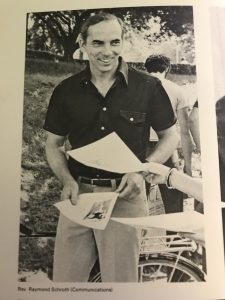
Most of us had begun as Ray’s students at one Jesuit university or another, Fordham included. He was blatantly magnetic, a man-about-campus with a playful smile and form-fitting Izod shirt. But his main devotions were interior: to intellectual pursuits and his vocation as a priest. He celebrated Mass with a marked sincerity and taught his classes with a passion. He published his writing—rigorous journalism with a disarming dash of memoir—in national publications. And in his music-filled apartment, next to the armchair, was an elbow-high stack of magazines and books. He would read them all, sometimes late into the night after a steak-and-martini dinner with friends at an Arthur Avenue restaurant, rebuilding the stack as he went.
Somehow, Ray made his life of the mind seem glamorous—like if you yourself couldn’t get in on it, you’d keel over from an acute lack of fulfillment. Then one day he’d tap you on the shoulder, so to speak, and allow that he saw something in you. This was both thrilling and nerve-racking for the way it made you want to measure up. It embarked you on what felt like an adventure of spiritual striving and cold ocean swimming, high literary endeavor and incessant bonhomie. The bonus was membership in a community not of his followers but his brethren.
Years later, at the memorial at Fordham, a few of us sang his praises. “Ray was not a Catholic apologist but he was also not an apologetic Catholic,” said Kevin Doyle, FCRH ’78, a lawyer who has applied himself to defending men on death row. “He ached to be generative,” added Anne Gearity, TMC ’70, GSS ’74, about Ray’s zeal for teaching. She herself is a therapist who teaches children to cope with trauma.
Author Eileen Markey, FCRH ’98, noted the absence of Ray’s prize student, Jim Dwyer, FCRH ’79, who’d been one of his closest friends. A Pulitzer Prize-winning columnist of impeccably chiseled prose, Jim had been lined up long ago to deliver the eulogy. But before a memorial could be held, he died of cancer, a loss so devastating that it bordered on the absurd. All the more reason, Eileen observed, to gather at liturgy and find shelter with each other.
Afterward at a reception, there were mini muffins and comforting conversation, which is how I imagine the anteroom of heaven. Still, life haunts you. I kept dwelling on what Kevin Schroth, a professor at the Rutgers School of Public Health, had said at the Mass about the last two years of his uncle’s life: “Ray told me he was at peace with his condition, that he understood why he had to go through it.”
On a summer day in 2018, Ray was taking a walk on Webster Avenue when a stroke knocked him to the pavement. Remember those righteous men and women of the Talmud? This is how they quietly move among us, keeping chaos at bay through the practice of some discipline, until the chaos comes for them. Ray lost his ability to walk and write and gained a problem with swallowing that put him on a feeding tube. He entered a season of suffering. And yet, he clung to delight. He’d still beam at the sight of friends at his door, lifting his head as if lit from within. As if no loss in the world could keep him from loving you.
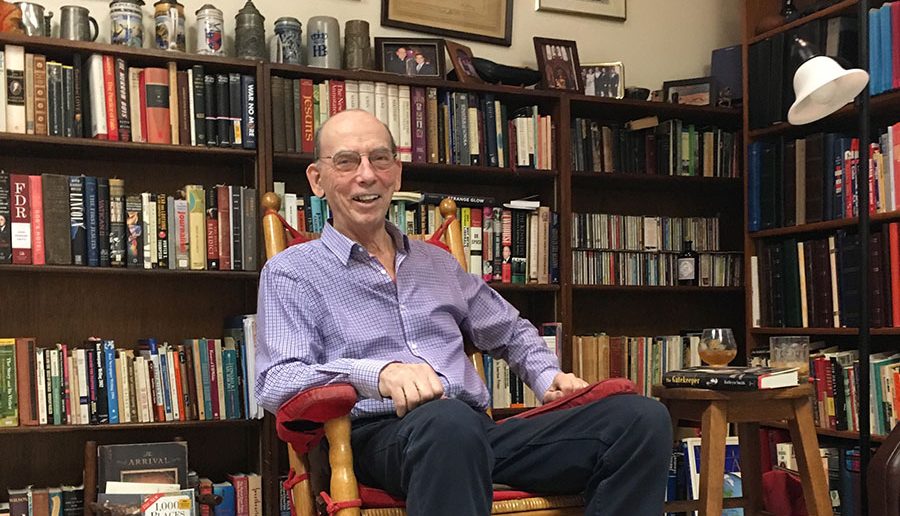
—Jim O’Grady, FCRH ’82, recently joined NPR’s Planet Money as a host and reporter after more than a decade at WNYC, where he earned numerous honors, including two Edward R. Murrow Awards. He is also the host of the podcast Blindspot: The Road to 9/11, a co-production of HISTORY and WNYC Studios.
Scenes from the memorial Mass and reception held at Fordham on October 23, 2021. Photos by Bruce Gilbert
[doptg id=”173″] ]]>“Father Schroth—Ray, as many of us knew him—was a towering figure at Fordham: he was a beloved professor, a treasured colleague, a lucid journalist and writer, and an insightful historian of the University and the Jesuits,” said Joseph M. McShane, S.J., president of Fordham. “He was wise, compassionate, and rigorous, and held his colleagues and students to his own very high standards. We will miss him greatly, and we will keep him and his loved ones in our prayers.”
Father Schroth received a bachelor’s degree from Fordham College at Rose Hill in 1955. In 1969, he returned to his alma mater as an associate professor who taught journalism in the communications department. During that time, he became the first person in University history to be granted tenure by the Faculty Senate, after initially being denied tenure by his department. The tense battle was covered by The New York Times, which referred to him as “probably the most popular teacher on campus.” He did earn tenure, thanks to a majority vote, student support, and the intervention of James C. Finlay, S.J., president of Fordham at the time.
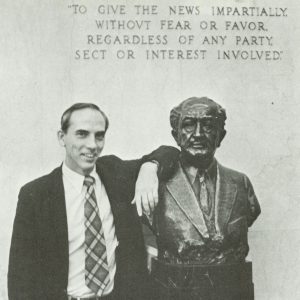
“Many of us on the Faculty Senate at the time, including myself, felt that a rejection by his tenured faculty in his department was not an appropriate decision. He was known by us to be a good teacher and a popular teacher,” recalled Robert Himmelberg, Ph.D., professor emeritus of history.
For decades, Father Schroth taught American literature and journalism and/or served as academic dean at at least six universities. In 1979, Father Schroth left Fordham to become academic dean at Rockhurst University (formerly known as Rockhurst College) in Kansas City, Missouri. But almost two decades later, he returned to Fordham, where he served as assistant dean of Fordham College at Rose Hill from 1996 to 1999.
In August 2016, he moved to Murray-Weigel Hall for health reasons. After experiencing a bad fall in 2017, he was confined to a wheelchair and “accepted reluctantly, but with faith, his disabilities,” read his obituary from the Jesuits USA Northeast Province.
“I think of the different seasons of Ray’s life on that campus, from a young man in the ’50s to a young priest just beginning his work in the late ’60s, to this robust and storied presence in the ’90s. And now, in his last couple of years, a man who really suffered under the weight of age and infirmity,” said journalist Eileen Markey, FCRH ’98, past student and friend of Father Schroth’s who has served as an adjunct professor at Fordham. “All of those seasons on this campus really defined his life.”
‘At Heart Ray Is a Reporter’
Raymond Augustine Schroth was born in Trenton, New Jersey, on November 8, 1933, to Raymond Schroth, a journalist and U.S. Army veteran who was awarded the Distinguished Service Cross in World War I, and Mildred (née Murphy) Schroth, a teacher in the Trenton public and Catholic schools.
“Somehow I had made the basic decision inspired by both my parents’ lives: I wanted to write and teach, and that’s what Jesuits do,” he wrote in a 2007 story for the NJVoices column that reflected on his life.

Father Schroth served for two years as an officer in the U.S. Army with an anti-aircraft battalion in West Germany, where he found his two vocations: the priesthood and journalism. In 1957, he joined the Society of Jesus and was ordained as a priest a decade later. He went on to earn two degrees in addition to his Fordham degree: a bachelor of sacred theology degree from Woodstock College, Maryland, in 1968, and a Ph.D. in American thought and culture from George Washington University in 1971.
Journalism ran in his blood. His father served as an editorial writer for the Trenton Times, Brooklyn Eagle, and Philadelphia Record. His uncle, Frank D. Schroth, was the last publisher of The Brooklyn Eagle, according to a 1977 obit from The New York Times.
For most of his life, Father Schroth followed in his family’s footsteps. He reported from 14 countries, including Syria and Russia, according to America magazine. In the U.S., he covered the aftermath of the Detroit riots and the 1968 Democratic National Convention, among other historic events.
Throughout his lifetime, Father Schroth authored eight books, including Fordham: A History and Memoir (Fordham University Press, 2008), a 300-page document that chronicles 137 years of the institution’s history. Other titles include The American Jesuits: A History (NYU Press, 2007) and Bob Drinan: The Controversial Life of the First Catholic Priest Elected to Congress (Fordham University Press, 2010). He published more than 300 articles and reviews that have appeared in multiple publications, including the Los Angeles Times, The Boston Globe, the National Catholic Reporter, Commonweal, and Newsday. In 2010, he joined the editorial staff of America, where he served as literary and books editor until he retired in 2017 and received the title editor emeritus.
“At heart Ray is a reporter. … [H]e has never forgotten that an important part of a reporter’s job—especially for a Catholic journalist—is to tell the stories of ordinary people, the folks in the pews or on the streets,” Matt Malone, S.J., editor in chief of America: The Jesuit Review and president of America Media, wrote in a 2017 story.
In that piece, Father Malone quoted something Father Schroth wrote on teaching: “The first step in teaching moral values to young journalists is to get them to feel pain—not their pain, the pain of others. From that, other virtues—compassion, skepticism, courage and the like—might follow.”
Mentor to Students ‘From All Eras’
Father Schroth loved to tell stories. That was clear in the ’70s, if you entered his room and studied the walls, and even two years ago, in his room at Murray-Weigel Hall.
“You could come into his living room and see posters about strikes or political events that were going on, or you could see these very of-the-moment nonfiction books,” recalled Jim Dwyer, FCRH ’79, a two-time Pulitzer Prize-winning journalist who writes for The New York Times. “For an 18- or 19-year-old, it was a portal from the protected world of the campus to the wider world beyond.” He shared that passion with his students, too.
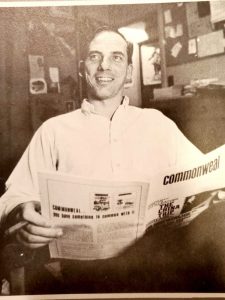
“There’s this fraternity of Ray’s students from all eras, people ranging from their mid-sixties down to those of us in our forties or thirties, and people at all kinds of publications all over the country,” said Markey.
Father Schroth urged students to fact-check official statements from powerful figures, past students recalled. He was a writer who despised the phrase “the fact that” and emphasized the importance of writing concisely. He taught young journalists to set high standards for themselves and their work, and he stressed the importance of using their stories as “a force for change,” said another alumna.
“In the early ’70s, the thinking in journalism was that a reporter had to report both sides of the story and be this impartial person … He understood that view, but he also presented the view that journalism was a force for change and a voice for the underdog and the underprivileged,” said Loretta Tofani, FCRH ’75, a retired investigative journalist.
Father Schroth introduced Tofani to the work of several investigative journalists who played a role in her Pulitzer Prize-winning exposé of prison rape for The Washington Post, she said.
Exposing students to important works and history was a priority for Father Schroth. He convinced his colleagues to come up with an annotated list of the most significant 10 books they had read, which he shared with his students as a guide to life, said Roger Wines, Ph.D., professor emeritus of history. He spearheaded the “Great Walk,” an annual student trek between the Battery in Manhattan and the Rose Hill campus—a way to explore the city and show students parts of New York that they might not otherwise see, said past students. Father Schroth also refused to become a “stale” professor.
Dwyer recalled one summer when he returned to campus and found Father Schroth in his room in Martyrs’ Court, shredding sheets of handwritten looseleaf notes.
“I’m tearing up my notes for the books I’m teaching this semester,” Father Schroth explained.
“Why on Earth would you do that if you’re going to be teaching them in a couple weeks?” Dwyer asked.
“To force myself to read the books anew, so I don’t become stale,” Father Schroth replied.
Connecting Students ‘to a Wider World’
In phone interviews, past students and colleagues described “Ray” as a stellar journalist and stalwart friend. He occasionally clashed with students, faculty, and his more conservative Jesuit brethren, but stood up for what he thought was right and inspired scores of students to do the same, they said.
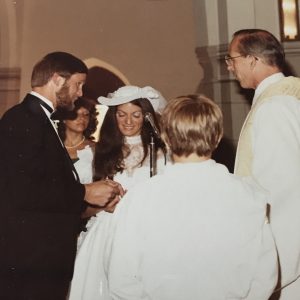
“One of the things that was really singular about Ray is his combination of intense rigor, high expectations, and personal standards, mixed with a tremendous sweetness and warmth,” said Markey. “Sometimes we think of those as two different things … But Ray did both.”
Father Schroth was a tall, lean man who stood so straight that it made you want to stand up straighter, said Markey. He was also an avid runner, bicyclist, and swimmer. At age 83, he walked for miles along the Camino de Santiago, a pilgrimage trail in Spain, as he recounted three years ago. He loved show tunes, especially songs sung by Nelson Eddy and Jeanette MacDonald, and persuaded his fellow pilgrims to sing with him as they trekked the Spanish countryside, said Dwyer. He also took his friendships very seriously.
“On Holy Thursday every year, he would send an email to many of us, saying, ‘This is when Jesus gathered his friends together and said, do this in memory of me, and this is a ritual of friendship and community, and that’s what we are to each other.’” said Markey.
Over the years, he created a box filled with index cards that listed the names of hundreds of friends and family members. Every time there was a birth, move, divorce, job change, or marriage, Father Schroth updated the cards.
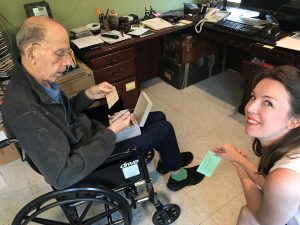
“He married students. He buried their parents and baptized their children. And he did all that for me,” said Dwyer. “But he did that for hundreds of people.”
“He connected me to the world of journalism, which has been my life for the last 40 years,” Dwyer continued. “But the bigger thing that Ray did for me and thousands of others is connect us to a wider world. He taught us that friendship has to be looked after—that it has to be cultivated and nurtured.”
Due to the COVID-19 pandemic, the wake and funeral Mass for Father Schroth at Murray-Weigel Hall will be private. He will also have a private burial at the Jesuit Cemetery in Auriesville, New York. His family will have a public memorial Mass when it is possible. Notes of condolence may be sent to his nephew, Kevin Schroth, at 79 Bingham Avenue, Rumson, NJ 07760.
]]>